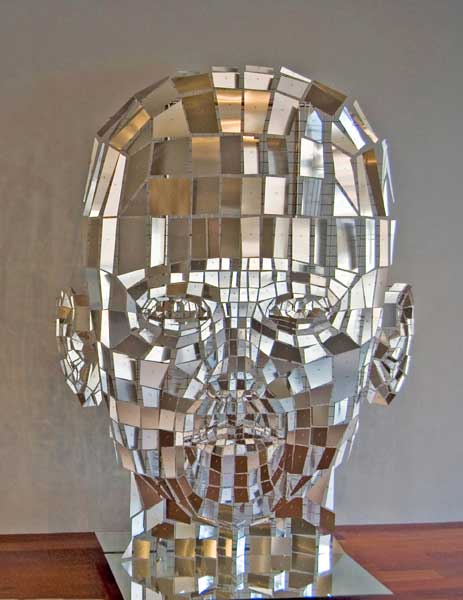Bright , Shiny and Kinetic
George Sherwood brings a somewhat unusual background to the creation of art. The Ipswich, Massachusetts, resident earned a BFA at the Hartford Art School back in 1976 and spent time as a street performer in Burlington, Vermont, before enrolling at the University of Vermont to a study for a degree in engineering (B.S. 1984). He […]

Steel life.
George Sherwood brings a somewhat unusual background to the creation of art. The Ipswich, Massachusetts, resident earned a BFA at the Hartford Art School back in 1976 and spent time as a street performer in Burlington, Vermont, before enrolling at the University of Vermont to a study for a degree in engineering (B.S. 1984). He then worked designing toys for Parker Bros., Hasbro, and Lego until 1998, when he decided to devote himself full-time to creating kinetic sculpture.
I first saw Sherwood’s elegant, shiny metal outdoor sculpture a few years ago, blowing in the wind on Hawk Ridge Farm in Pownal, Maine, where art dealer June LaCombe holds summer shows of garden art. This summer, 15 of Sherwood’s kinetic sculptures are being featured as George Sherwood: In Delicate Balance at the Currier Museum of Art in Manchester, New Hampshire (through September 6).
Inspired by the kinetic sculpture of George Rickey and the mobiles of Alexander Calder, Sherwood creates light, bright, and playful art objects that are actually precision machines attuned to air currents and light. They range in size from tabletop to tremendous, such as the 35-foot “Botanica,” swooping tendrils of steel with four leaves, currently installed on the Rose Fitzgerald Kennedy Greenway in Boston.
The Currier exhibition features two outdoor pieces and 13 indoor pieces, most taking their cues from the natural world.
“Many of the sculptures echo the vitality and gestures extracted from nature,” writes George Sherwood on his website. “The swaying of grass in a windy meadow, a flock of birds diving and swooping over the marsh, and the craning of a bird’s neck are patterns of movement that I have employed to give life to static forms.”
Sherwood works in polished stainless steel, a material that animates his creations further, making them shimmer, twinkle, sparkle, glint, glow and flash.
“The reflective qualities of stainless steel further the integration of the sculpture into its environment,” he explains. “Wind speed and direction, shades of light, time of day, precipitation, and seasonal color interplay to transform the qualities of light and movement. My sculptures are best viewed over extended periods to appreciate the interaction with their natural setting.”
“Fusion II,” for example, resembles an abstract flower when standing still, but when set in motion by the metal tines of the two “blossoms” seem to merge as they spin. “Steel Life I and II” are a pair of monumental human heads made of a foil-like metal such that the facial features change constantly with the light and one’s angle of vision.
George Sherwood’s cunning kinetic sculptures elevate the humble heritage of whirligigs, windmills, weathervanes, and wind chimes to the realm of fine art. They are probably best seen in the landscape or garden, but if you don’t have a garden, a museum will do. Sherwood is represented by Essex Fine Art in New London, New Hampshire.
[Currier Museum of Art, 150 Ash St., Manchester NH, 603-669-6144]
Edgar Allen Beem
Take a look at art in New England with Edgar Allen Beem. He’s been art critic for the Portland Independent, art critic and feature writer for Maine Times, and now is a freelance writer for Yankee, Down East, Boston Globe Magazine, The Forecaster, and Photo District News. He’s the author of Maine Art Now (1990) and Maine: The Spirit of America (2000).
More by Edgar Allen Beem

